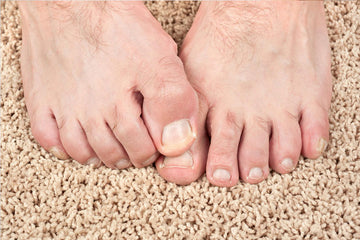Athlete's foot is a common fungal infection that affects the foot. Are you worried you may have a fungal infection? Read on to learn five things you should know about this foot condition.
1. WHAT CAUSES ATHLETE'S FUNGUS?
There are several fungal organisms that can cause fungal infections, but the most common is the dermatophyte. This microscopic fungus is normally found in the body along with other fungi and bacteria. When the toenails and skin are intact, the feet are adequately protected from infection. However, when the skin and toenails are damaged or broken (creating an opening), the fungus can enter. The warm, moist environment of the body is ideal for growth, and the fungi naturally multiply, resulting in a fungal infection.
The most obvious way to get a crack in the skin is through an injury. And indeed, an injury can be the trigger for a fungal infection. But most fungal entry points are less obvious, even undetectable. Damp, wet skin macerates, meaning it becomes soft and breaks down, making it vulnerable to the normally harmless fungus already on the skin's surface. This is why feet and toenails are more susceptible to fungal infections than fingernails, because feet are often stuck in shoes where they are exposed to the moisture of sweat for long periods of time. However, moisture doesn't necessarily have to be present to trigger a fungal infection. Extremely dry skin can form small micro-cracks where fungi can colonize and multiply.
Fungal infections are more common in older adults because skin and nails tend to be drier and more brittle, allowing the fungus to enter through cracks in the surface. People with weakened immune systems and reduced circulation are also at higher risk of developing athlete's foot.
When fungi attack the skin of the foot and between the toes, it is called tinea pedis or athlete's foot. When the fungus invades the toenails, it is called nail fungus or onychomycosis.
2. WHAT DOES ATHLETE'S FUNGUS LOOK LIKE?
Toenail fungus can start as a white or yellow patch under the free edge of the toenail. The deeper the infection goes, the darker and more yellow the nail becomes and the thicker, more brittle and more jagged it becomes. When the space between the toes is infected, the skin appears red, flaky and scaly and often peels, cracks, itches and burns. The classic "rough skin" that shows up as a dry, velcro-like heel can also be a fungal infection. Sometimes there is a foul odor, and in severe cases, blisters and sores can form on the feet. Fungal infections worsen over time, so it is important to start treatment at the first signs.
3. HOW TO TREAT ATHRACITE FUNGUS?
The worst thing you can do is ignore the problem by covering it up with nail polish. Severe cases can be very painful and cause permanent damage if left untreated. For example, undiluted iodine and repeated use of apple cider vinegar-based solutions can damage the skin.
Fortunately, there are safe, effective products available without a prescription. Watch for products that contain clotrimazole, an active ingredient commonly used to treat fungal infections.
For best results, apply the care products to clean, dry feet and toenails. Spray the product over the free edge of the nail so that it can penetrate under the free edge and over the top of the nail. When applying mousses, make sure that the product also gets into the spaces between the toes, where the fungus likes to hide.
4. IS ATHLETE’S FUNGUS CONTAGIOUS?
Yes! Athlete's foot is contagious... even between body parts! In most cases, the infection is spread from an infected toe to neighboring toes, but it is also possible to spread a fungal infection to other parts of the body. For example, toenail fungus can spread to the genitals (jock itch) when underwear comes into contact with infected feet when putting them on. Fortunately, this is rare.
It's also possible to contract athlete's foot by walking barefoot in an area where an infected foot has been, such as a public pool or dorm shower, or by sharing socks or shoes with an infected person. Improperly sanitized pedicure tools and equipment can also spread athlete's foot from one unsuspecting client to the next.
5. CAN ATHLETE’S FUNGUS BE PREVENTED?
Yes! Healthy, intact skin is the best protection against fungal infections, so keeping feet clean, dry, and properly moisturized (to avoid micro-tears and cracks) is important to prevent athlete's foot. Make sure feet are completely dry after bathing, and always wear clean socks. Wear a foot covering in wet, public areas like pools and gym showers, if possible. A regular pedicure keeps nails clean and neatly trimmed, and your podiatrist can check for any changes in your toenails. Make sure you go to a reputable salon that properly disinfects instruments between client appointments, and preferably uses foot baths with disposable insoles (as opposed to piped spas or pedicure thrones), as the insoles are one-time use and can be removed after use.















